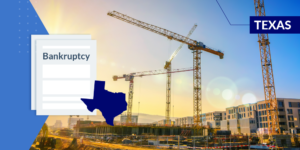
The construction industry’s payment issues are well documented — in 2021, 97% of surveyed construction professionals reported experiencing stress due to cash flow and payment-related issues — but the global pandemic put even more pressure on contractors and forced many into bankruptcy.
Seven different construction companies filed for Chapter 7 bankruptcy in March, 2022. These include:
- Quezinger, Inc. (March 30)
- ALJ Enterprise, Inc. (March 28)
- Triton Elevator, LLC (March 14)
- Najah Custom Homes, LLC (March 12)
- Dunn Pulaski Development, LLC (March 10)
- Prime Trailer Manufacturing, LLC (March 10)
- SCC Seymore Construction Co., LLC (March 7)
Chapter 7 bankruptcy can be bad news for a company’s creditors: This type of bankruptcy means a business is liquidating its assets and frequently results in a total shutdown.
Learn more about what different bankruptcy chapters mean.
One bankrupt construction business, Najah Custom Homes, appears to have been hit hard by a number of legal actions after several years of no profits.
Bankruptcy filing documents show Najah’s only reported assets are a lien, filed for $61,000, and a pending lawsuit for $164,000. The lawsuit is against Najah’s largest creditor — Leap Power Solution, LLC — who filed a $1 million claim against Najah and is currently in litigation over the matter.
Najah’s fillings list several other unsecured creditors who are at risk of losing out on money owed to them in the event Najah loses its suit against Leap Power Solution and can’t recover its assets.
Triton Elevator, another business facing Chapter 7 bankruptcy, also faced sliding revenues over the last several years. Financial documents show a rapid decline in revenue from $4.3 million in 2020 to $1.8 million last year, and finally just $85,000 from January 1, 2022, to date. Bankruptcy filings show they have little in the way of assets but are facing liabilities of more than $2.8 million, largely in the form of debt to a variety of material suppliers.
Even contractors with high revenues listed faced difficulties last month. Dunn Pulaski Development’s bankruptcy filings report revenues between $500,000 and $1 million, but with zero assets and over $1 million in debt as the result of a lawsuit judgment, the contractor was forced to file for bankruptcy.
All three of these contractors have recently or are currently facing at least one lawsuit, a factor that likely exacerbated existing financial pressures and pushed the businesses to the point of failure.
As the economy continues to recover from the effects of the global pandemic, it’s clear that contractors aren’t out of the woods just yet. Normal industry pressures have been made worse by two years of a turbulent economy, and many contractors are finding it difficult to stay afloat. While there is some sign of growth in the industry, it remains uncertain what’s ahead for contractors in this volatile economy.
It’s important for contractors to protect cash flow by securing the right to payment. These recent Texas bankruptcies could pose a significant risk for subcontractors and suppliers, and bankruptcies can set off a chain reaction of collapses in the current precarious industry.